Science fiction films This is a list of science fiction films organized chronologically. These films have been released to a cinema audience by the commercial film industry and are widely distributed with reviews by reputable critics. This includes silent film–era releases, serial films, and feature-length films. All of the films include core elements of science fiction, but can cross into other genres such as drama, mystery, action, horror, fantasy, and comedy.

The space marine is an archetype of military science fiction describing a kind of soldier who operates in outer space or on alien worlds. Historical marines fulfill multiple roles: ship defence, boarding actions, landing parties, and general-purpose high-mobility land deployments that operate within a fixed distance of shore or ship. By analogy, hypothetical space marines would defend allied spaceships, board enemy ships, land on planets and moons, and satisfy rapid-deployment needs throughout space.

Bishop, designated HS17B48XG5-D5, is a fictional character in the movie Aliens, who was portrayed by actor Lance Henriksen. The character is the science officer of the Sulaco, and his actions and self-sacrifice are critical to the survival of Ellen Ripley. When Ripley discovers that Bishop is an android, just like Ash, an antagonist of the first Alien film, she initially treats him with extreme distrust due to her previous experiences.

A fictional currency is some form of system of money defined, depicted, or alluded to, in works of fiction, such as novels, films or video games. The names of units of such currency are sometimes based on extant or historic currencies while other names, such as "Kalganids" in Asimov's Foundation series, may be wholly invented. A particularly common type, especially in science fiction, is electronically managed "credits". In some works of fiction, exchange media other than money are used. These are not currency as such, but rather nonstandard media of exchange used to avoid the difficulties of ensuring "double coincidence of wants" in a barter system.
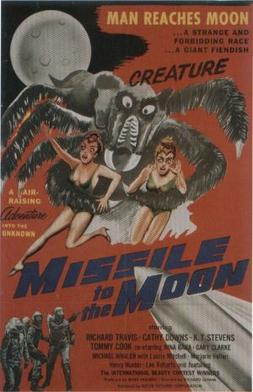
Missile to the Moon is a 1958 independently made American black-and-white science fiction film drama, produced by Marc Frederic, directed by Richard E. Cunha, that stars Richard Travis, Cathy Downs, and K. T. Stevens. The film was distributed by Astor Pictures and is a remake of an earlier Astor Pictures-distributed film, Cat-Women of the Moon (1953). Missile to the Moon was released in late 1958 as a double feature with Cunha's Frankenstein's Daughter.

Alienator is a 1990 science fiction film directed by Fred Olen Ray, produced by Jeffrey C. Hogue, and starring Jan-Michael Vincent.

The Creation of the Humanoids is a 1962 American science fiction film release, directed by Wesley Barry and starring Don Megowan, Erica Elliot, Frances McCann, Don Doolittle, and Dudley Manlove. The film is not based on the plot of Jack Williamson's novel The Humanoids (1949), to which it bears little resemblance, but on an original story and screenplay written by Jay Simms.

The Psychotronic Man is a 1980 American science fiction cult film directed, shot and edited by Jack M. Sell, and written, produced and starred Peter G. Spelson. The film opened in Chicago at the Carnegie Theatre on April 23, 1980.
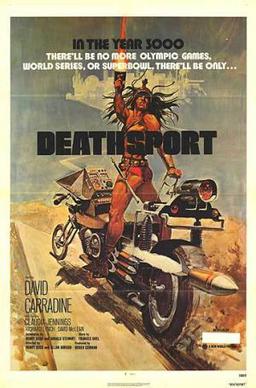
Deathsport is a 1978 science fiction B-film produced by Roger Corman and directed by Allan Arkush and Nicholas Niciphor. The film stars David Carradine and Playboy Playmate Claudia Jennings. It would be one of Jennings' last films before her death.

Psychotronic Video was an American film magazine founded by publisher/editor Michael J. Weldon in 1980 in New York City, covering what he dubbed "psychotronic movies", which he defined as "the ones traditionally ignored or ridiculed by mainstream critics at the time of their release: horror, exploitation, action, science fiction, and movies that used to play in drive-ins or inner city grindhouses." It was published through 2006. Most of the magazine's hundreds of reviews were written by Weldon himself. Other contributors provided career histories/interviews with cult filmmakers and actors such as Radley Metzger, Larry Cohen, Jack Hill, William Rotsler, David Carradine, Sid Haig, Karen Black, and Timothy Carey. Regular features included "Record Reviews" by Art Black, "Spare Parts" by Dale Ashmun, and "Never To Be Forgotten", an obituary column.

Triplanetary is a science fiction novel and space opera by American writer E. E. Smith. It was first serialized in the magazine Amazing Stories in 1934. After the original four novels of the Lensman series were published, Smith expanded and reworked Triplanetary into the first of two prequels for the series. The fix-up novel Triplanetary was published in book form in 1948 by Fantasy Press. The second prequel, First Lensman, was a new original novel published in 1950 by Fantasy Press.

Galactic Patrol is a science fiction novel by American author E. E. Smith. The novel was originally serialized in the magazine Astounding in 1937. The stories in this volume were the first parts written of the original Lensman saga. It was later published in book form in 1950 by Fantasy Press.
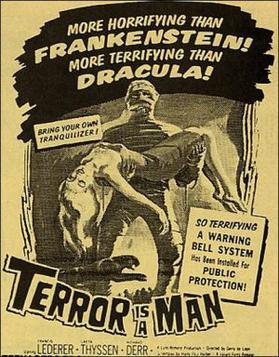
Terror Is a Man is a 1959 black-and-white Filipino/American horror film directed by Gerardo de Leon.
Nicholas "Nick" J. Corea was an American author, television writer, director, producer and painter. Though best known for his work on The Incredible Hulk and its sequel 1988 telefilm The Incredible Hulk Returns, he was involved with many television series during the late 1970s and 1980s including The Oregon Trail, Airwolf, Street Hawk, Hard Time on Planet Earth and Booker. He was also the creator of the 1986 western series Outlaws.
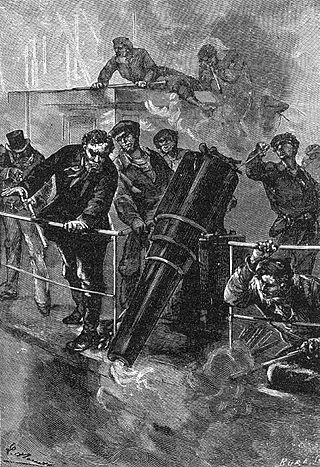
Air pirates are a class of stock character from science fiction and fantasy.
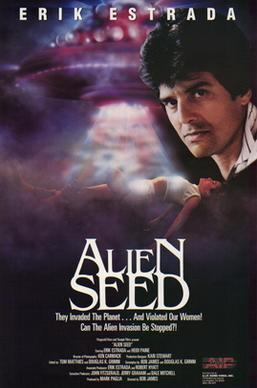
Alien Seed is a 1989 American science fiction film written and directed by Bob James and starring Erik Estrada. It was released by action International
Sara Suzanne Brown is an American actress who is best known for her appearances in softcore erotic films between 1991 and 1995. She made her film debut in a small role as a background dancer in The Last Boy Scout (1991). Among her films include Secret Games 2: The Escort (1993), Mirror Images 2 (1993), Test Tube Teens from the Year 2000 (1993), and Killer Looks (1994).














